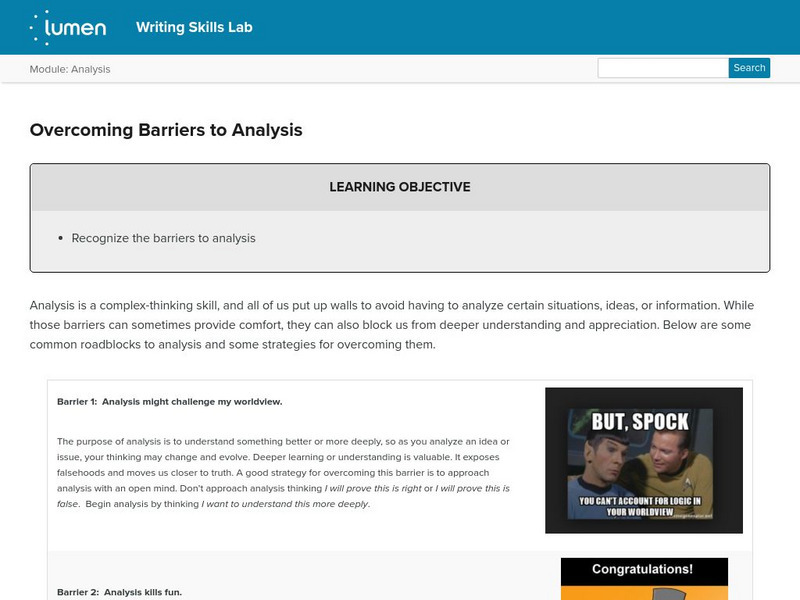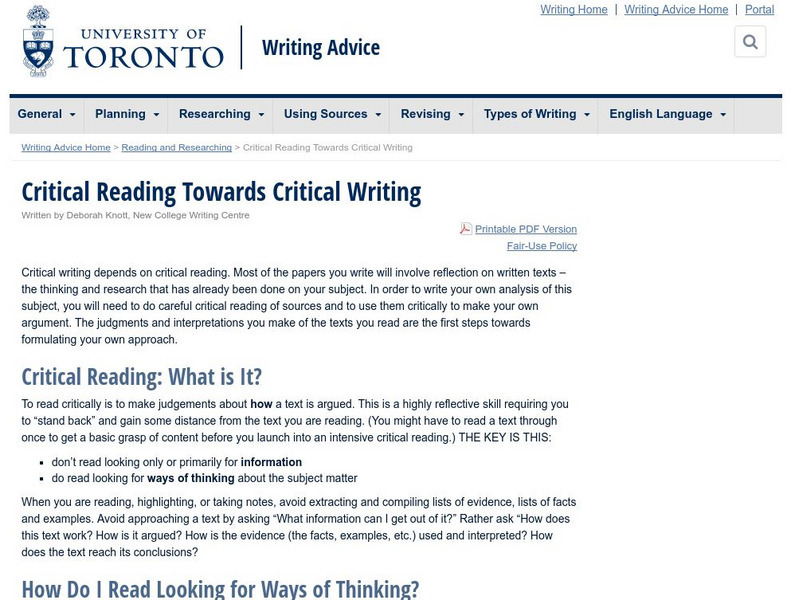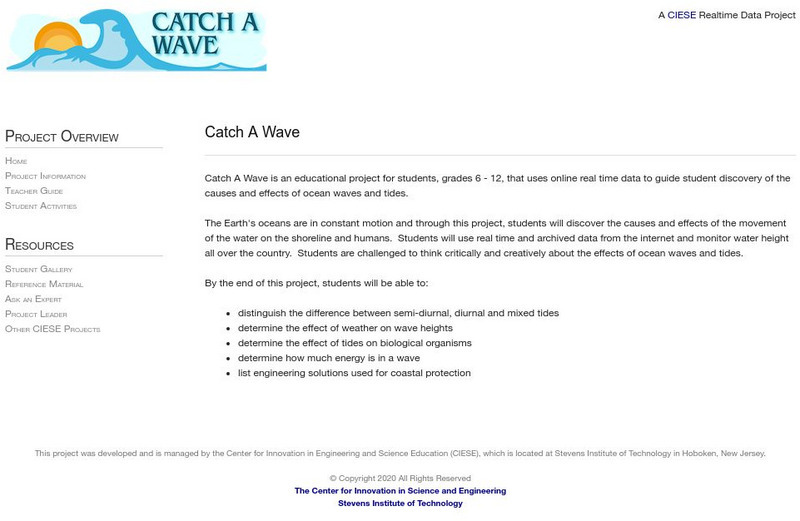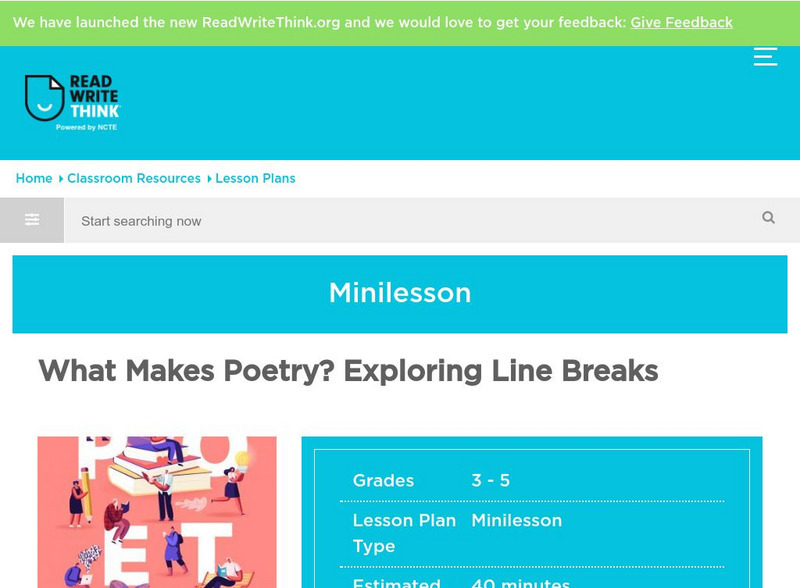College Board
AP® Psychology: Teaching Statistics and Research Methodology
Psychologists use statistics? Scholars investigate the research behind the methodology of statistical analysis. Using hands-on practice, case-studies, and scatterplots, they complete various tasks to understand the very roots of high...
Science Education Resource Center at Carleton College
Serc: Using Egg Drop Activity to Promote Critical Thinking and Analysis Skills
In this multi-lesson hands-on inquiry activity, students will develop their critical thinking skills by designing and constructing an apparatus that will permit an egg to survive a nine foot fall. Given limited materials, they will...
Virtual Salt
Virtual Salt: Introduction to Critical Thinking
An introduction to the concept of Critical Thinking examines the true definition and gives examples where it can be used as a constructive force.
Other
Flickr: Critical Thinking Skills Poster
A downloadable critical thinking skills poster based on the original six levels of Bloom's taxonomy.
Lumen Learning
Lumen: Analysis: Overcoming Barriers to Analysis
This lesson focuses on understanding and overcoming barriers to analysis: Barrier 1: Analysis might challenge my worldview, Barrier 2: Analysis kills fun, and Barrier 3: Analysis invents meaning.
Other
In Time: Tenets of Democracy: Critical Thinking and Decision Making
This critical thinking exercise and checklist is designed for teachers and students. A lesson plan can be developed here that illustrates decision-making skills and a teacher can use examples of common problems that get in the way when...
Science Education Resource Center at Carleton College
Serc: Rainfall and Elevation: A Charting and Critical Thinking Exercise
In this lab, students will learn to organize and present data in a visual way so that they can then summarize in writing their conclusions about the relationships between the data.
Sophia Learning
Sophia: Critical Reading as a Learning Strategy
This tutorial focuses on critical reading using a downloadable PowerPoint presentation, "Critical Reading 101," which includes separating fact from opinion, 6 propaganda techniques, and 6 common fallacies in reasoning. Also provided is...
Science Education Resource Center at Carleton College
Serc: Learning About Dimensional Analysis and Stoichiometry
Help your students learn the skill of dimensional analysis and the importance of mastering that skill. For this activity, students will work on their critical thinking by solving dimensional analysis problems. The lesson is formatted on...
Lumen Learning
Lumen: Analysis: Putting It Together: Analysis
This lesson focuses on analysis including an understanding of what analysis is, the keys to effective analysis, and the types of analytic assignments.
ReadWriteThink
Read Write Think: Book Sorting: Using Observation and Comprehension
Critical thinking, comprehension and analysis skills are the focus of this physical activity. Good beginning to teaching different ways of looking at things.
University of Glasgow
University of Glasgow: Critical Reviews
This site is designed to be used by psychology students at the university level, but it provides helpful instruction for anyone writing critical reviews of non-fiction. Instruction includes everything from how to be critical to...
ReadWriteThink
Read Write Think: Improving Student Writing Through Critical Thinking
Contains plans for a lesson plan about writing draft letters, or reflective letters about pieces of writing that students are submitting to an instructor. In addition to objectives and standards, this instructional plan contains links to...
Other
Univ. Of Mississippi: Critical Approaches to Literature
Here are nine common critical approaches to the study of literature based on X.J. Kennedy and Dana Gioia's Literature: An Introductionto Fiction, Poetry, and Drama.
Books in the Classroom
Carol Hurst's Children's Literature Site: Looking Critically at Picture Books
This site describes several ideas and activities to use with picture books and intermediate/middle school age students. Specific title to use are also given.
Other
Aventis Learning Group: Systems Thinking: The What, Why, When and How
Systems thinking is a holistic approach to analysis that focuses on the way that a system's constituent parts interrelate and how systems work over time and within the context of larger systems. It is particularly useful in addressing...
Annenberg Foundation
Annenberg Learner: America's History in the Making: Historical Thinking Interactives
Six interactive activities are presented that walk students through how to use their critical thinking skills in the analysis of historical artifacts and documents. The sixth one explains how to balance the various perspectives that...
Library of Congress
Loc: Photo Analysis Presenting the Statue of Liberty
The ability to examine a primary source is a gateway to building critical thinking skills and constructing knowledge. This lesson provides the students an opportunity to observe similarities and differences between 2 visual images,...
University of Toronto (Canada)
University of Toronto: Critical Reading Towards Critical Writing
Aimed particularly towards writing about non-fiction, this site describes ways to think about what you read so you can write more clearly. Focuses on analyzing the "ways of thinking" that an author uses so you can evaluate the validity...
Other
Csicop: Field Guide to Critical Thinking
This article, originally published in Skeptical Inquirer, outlines some of the key components of the scientific problem-solving process while addressing the many reasons for the popularity of paranormal beliefs in the U.S. (Published in...
Stanford University
Stanford University: Spatial History Project
Several individual projects are going on under the umbrella of the Spatial History Project. These projects are developed and worked on by students, staff, and scholars as they expand studies within the humanities through spatial,...
Center for Innovation in Engineering and Science Education, Stevens Institute of Technology
Ciese: Catch a Wave
In this project for Grades 6 to 12, students will use real data collected online to learn how waves and tides work. They will learn what causes water to move, and how waves and tides impact on humans, organisms and waterfront lands. They...
ReadWriteThink
Read Write Think: It Doesn't Have to End That Way
Literary response and prediction are the focus of this lesson plan. Knowing story structure is an important skill for literary analysis, and this gives teachers a way to help learners develop this skill. Includes links to web resources,...
ReadWriteThink
Read Write Think: What Makes Poetry? Exploring Line Breaks
This lesson explains how analyzing poetry is a many-layered process. This lesson introduces the special characteristics of poetry and leads young scholars through a look at how poems are structured and why. Includes links to poems and...


















